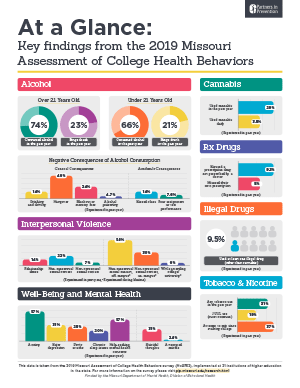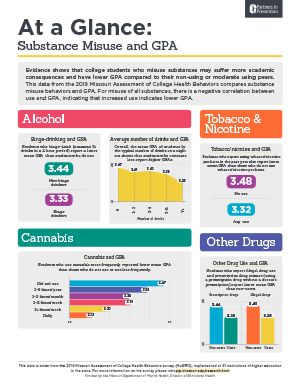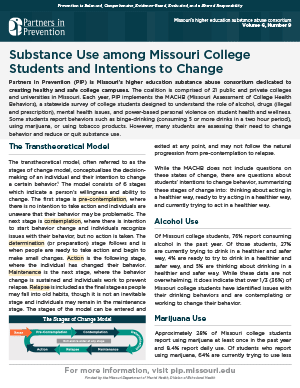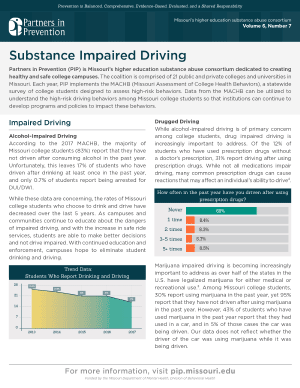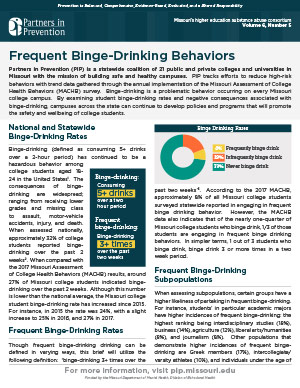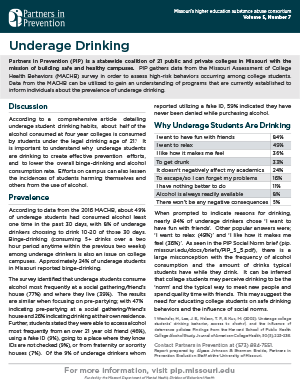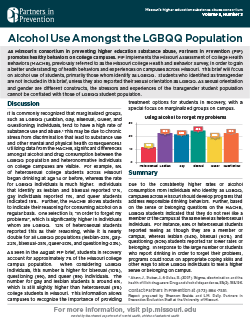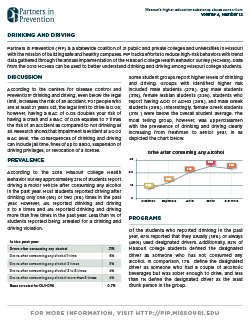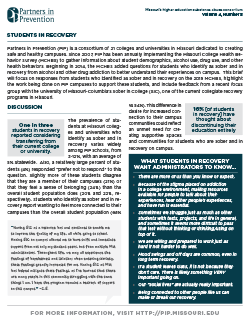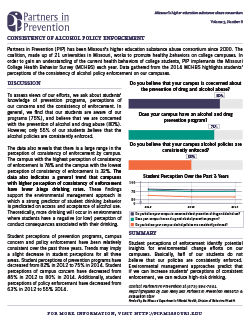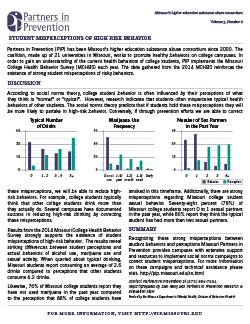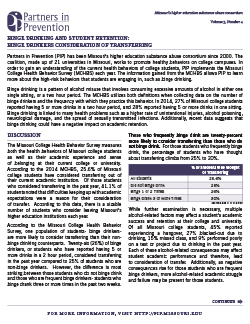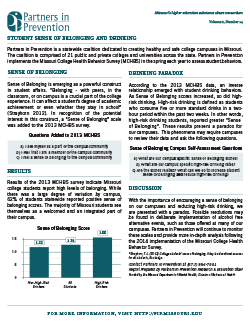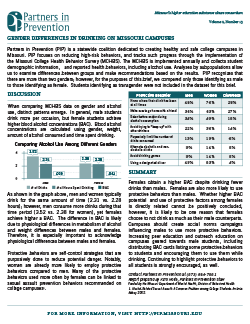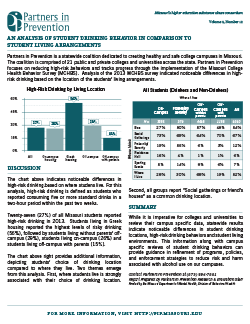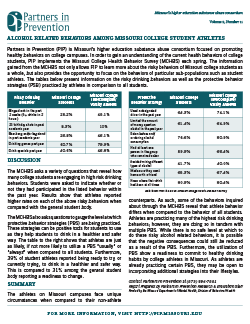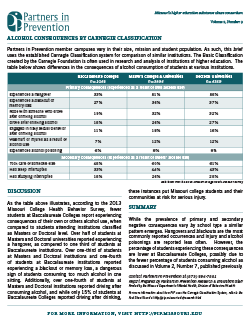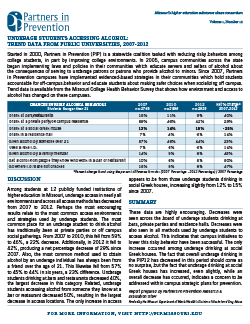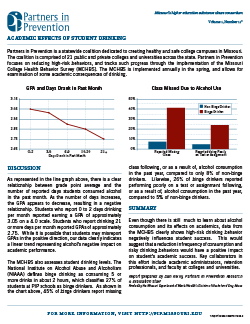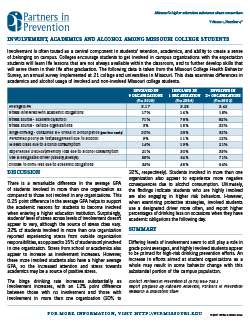
Alcohol and High-Risk Drinking

Alcohol use among college students is often seen as a “rite of passage” and most Missouri college students (75%) have consumed alcohol in the past year*.
Many of these students drink in a healthy and safe way; however, there are a number of high-risk drinking behaviors that negatively affect college students. Compiled here are resources to help address different high-risk drinking behaviors. (*MACHB 2018)
Scope
National Data
60% of college students drank in the past month, and
almost 2 out of 3 engaged in binge drinking
Approximately 1,800 college students die from alcohol-related unintentional injuries (including motor vehicle crashes) each year
About 696,000 students are assaulted by another student who has been drinking
Approximately 97,000 students report experiencing alcohol-related sexual assault
About 1 in 4 students report academic consequences from drinking (missed class, performing poorly on exams/papers, lower grades overall
About 20% of college students nationwide meet the criteria for an alcohol use disorder
Missouri Data
Approximately 25% of Missouri college students meet criteria for binge drinking (4+ drinks in 2 hours for women, 5+ drinks in 2 hours for men) in the past 2 weeks, and 33% meet criteria for binge drinking in the past 30 days
12% of Missouri college students report being forced, pressured, or coerced into consuming more alcohol than they wanted at least once in the past year
Missouri college students who drink report consequences from drinking including:
| 49% | 21% | 16% | 12% | 9% | 9% | 5% |
| Hangover | Rode w/non-sober driver | Missed class | Forced to drink more | Hurt/injured | Low school performance | Alcohol poisoning |
Sixty-six percent of Missouri college students who are under the age of 21 report drinking in the past year.
...and 23% meet criteria for binge drinking in the past two weeks
Students under 21 report that they obtain alcohol from:
| 45% | 15% | 9% | 8% |
| 21+ friend | Family member | ID not checked | Fake ID |
Though it is never safe to drink and drive, 16% of Missouri college students report driving after consuming alcohol in the past year
*all Missouri data is from the MACHB 2018*
High-Risk Drinking Behaviors
Binge Drinking: Binge drinking is a pattern of alcohol consumption that brings the blood alcohol concentration (BAC) to .08% or more. This corresponds to 5+ drinks on a single occasion/in 2 hours for men, and 4+ drinks for women on a single occasion/in 2 hours. Binge drinking is associated with health problems and other issues including unintentional injury, violence including homicide, suicide, intimate partner violence and sexual assault, memory and learning problems, and alcohol dependence.
Heavy Episodic Drinking: For men, heavy drinking is defined as 15 or more drinks per week and for women, 8 or more drinks per week. It can also be defined as 5 or more binge drinking days per month. Heavy drinking can increase the risk of reproductive health issues and sexual function issues, certain kinds of cancer (especially mouth, throat, and liver cancers), heart disease, and more.
Underage Drinking: Studies have shown that alcohol use by adolescents and young adults increases the risk of injury, alcohol dependency, risky sexual behavior, and poor performance in school. Brain development continues well into adulthood (around age 25) and repeated alcohol use may lead to impairment of brain function.
Drinking and Driving: Alcohol use slows reaction time, impairs judgment, and causes loss of coordination. It is never safe to drive after consuming any alcohol.
Alcohol and Medications: Mixing alcohol and medicines can be harmful, even over the counter medicines. Drinking alcohol can intensify the effects of the medicine and individuals may experience negative side effects. The most common are drowsiness, dizziness, changes in heartbeat and blood pressure, liver/stomach damage, and increased risk for overdose. Always read medication labels and avoid drinking alcohol after consuming any medications.
Alcohol and Illicit Drugs: Combining alcohol and any illegal substance can be dangerous, and you cannot be 100% sure of what you are taking. Combining alcohol (a depressant) with a stimulant (such as cocaine) puts your central nervous system, respiratory system, and cardiovascular systems under pressure and can cause organ damage. Combining alcohol with another depressant (such as Xanax) and the effects can multiply, severely depressing your central nervous system and putting you at risk for overdose or death.
Alcohol Use Disorder
Alcohol Use Disorder (AUD) is problem drinking that becomes severe enough to be given a medical diagnosis. AUD is a chronic relapsing brain disease characterized by compulsive alcohol use, loss of control over alcohol intake and a negative emotional state when not using (NIH, 2017).
Risk Factors for AUD include:
- More than 15 drinks per week if you’re male
- More than 12 drinks per week if you’re female
- More than 5 drinks per day at least once a week (binge drinking)
- A parent with alcohol use disorder
- A mental health problem, such as depression, anxiety, or schizophrenia
Signs of AUD include:
- Drinking alone
- Drinking more to feel the effects of alcohol (having a high tolerance)
- Becoming violent or angry when asked about their drinking habits
- Not eating or eating poorly
- Neglecting personal hygiene
- Missing work or school because of drinking
- Being unable to control alcohol intake
- Making excuses to drink
- Continuing to drink even when legal, social, or economic problems develop
- Giving up important social, occupational, or recreational activities because of alcohol use
Data Briefs
Click on a brief below for more information.
At a Glance
Volume 6
Volume 5
Volume 4
Volume 3
Volume 2
Volume 1
Best Practices
Quick Links
College AIM | Campus and Community Policies | Social Norms Approaches | Comprehensive ApproachCollege AIM
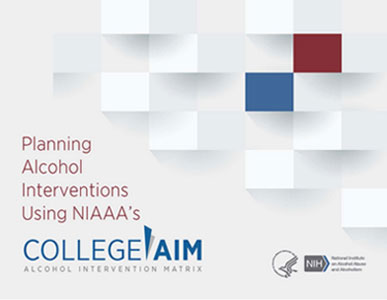
CollegeAIM—the College Alcohol Intervention Matrix—is a new resource to help schools address harmful and underage student drinking. Developed with leading college alcohol researchers and staff, it is an easy-to-use and comprehensive tool to identify effective alcohol interventions.
While there are numerous options for addressing alcohol issues, they are not all equally effective. CollegeAIM can help schools choose interventions wisely—boosting their chances for success and helping them improve the health and safety of their students.
Looking for more information on the programs listed for the matrix? Click here for more information about these programs:
- Enforcing Age-21 Drinking Age (e.g. compliance checks)
- Enacting Responsible Beverage Training Laws
- Prohibit Alcohol Use and Sale at Campus Sporting Events
Campus and Community Policies
The policies on campus actively shape the behaviors and choices of students. The following practices can reduce alcohol consumption and related issues on campus:
- Establishing alcohol-free residences on campus
- Prohibiting of alcohol at campus events
- Having a “dry” campus
- Banning sales or marketing of alcohol on campus
- Communicate the institution’s, the community’s, and the State’s alcohol policies to students and parents before and after students arrive on campus
- Medical amnesty/good Samaritan policies to increase help seeking
Community policies can shape behavior as well. If your campus does all of the above, there are likely still areas that students can go that are relatively close to campus to engage in drinking. Work with places in the community to do the following:
- Actively enforce alcohol laws and policies for MIP, MIPS, open container, public intoxication, etc.
- Create a task force or coalition to develop and monitor alcohol policies and enforcement
- Require a minimum drink price to avoid “bottomless cups” or specials that encourage binge drinking (penny pitchers, dollar shots, etc.)
- Restrict licenses for retail sales of alcohol, specifically within 1 mile of campus. Studies have shown that density of alcohol outlets correlates to higher alcohol consumption and related issues such as violence and crime
- Limiting hours/days of sale
Social Norms Approaches
Social norms are “the customary rules that govern behavior in groups and societies” (Stanford Encyclopedia of Philosophy). The social norms approach works to correct misperceptions that people hold about behaviors. People tend to over-estimate negative behaviors and under-estimate positive behaviors, and social norms help to positively influence behavior by message framing and providing accurate information about people’s choices.
Comprehensive Approach
A comprehensive approach is needed to address high risk drinking behaviors among college students. Prevention efforts should focus not just on individual and group level intervention, but also to the community and institution level. Developing a strategy, overseeing implementation, and evaluating a comprehensive approach is vital to enact change, and will require hard work and dedication.
- The NIH provides a great literature review of environmental-based community interventions
- The Alcohol Policy Information System is a detailed database of alcohol-related policies in the U.S. for both state and federal policies
- The Washington Alcohol & Drug Abuse Institute has a great database on evidence-based practices for treating substance use disorders
- SAMHSA’s National Registry of Evidence-based Programs and Practices is a good tool to find evidence-based approaches around substance use disorder prevention and treatment
National Resources
- National Association of State Alcohol and Drug Abuse Directors (NASADAD): nasadad.org/prevention-resources
- National Institute on Drug Abuse: drugabuse.gov
- National Institute on Alcohol Abuse and Alcoholism: niaaa.nih.gov
- Substance Abuse and Mental Health Services Administration (SAMHSA): samhsa.gov
- Alcohol Use Disorder Resources: alcoholrehabguide.org/resources
- Hazing Prevention Toolkit for Campus Professionals: www.stophazing.org
- NIAAA Alcohol Treatment Navigator: alcoholtreatment.niaaa.nih.gov
- Practitioners Toolbox: campusdrugprevention.gov/content/practitioners-toolbox
PIP Resources
Brochures & Posters
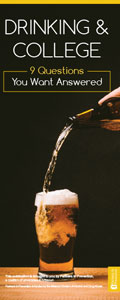
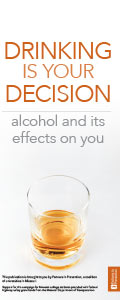
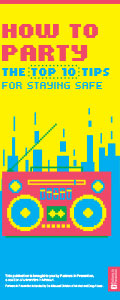
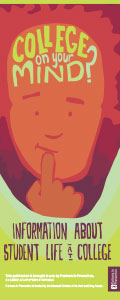

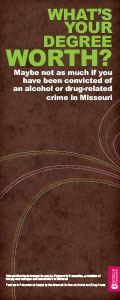
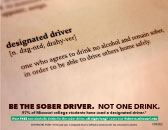
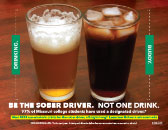

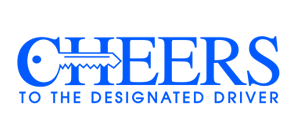 |
Bars, restaurants and nightclubs participating in CHEERS provide FREE non-alcoholic beverages to the acknowledged designated driver in a group of two or more. Click here to learn more about CHEERS! |
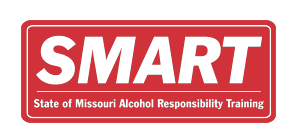 |
The State of Missouri Alcohol Responsibility Training (SMART) program is an interactive, web-based course available free of charge to those who own or work for any Missouri establishment licensed to sell alcohol. Click here to learn more about SMART! |
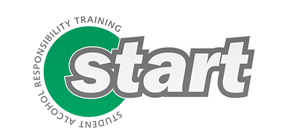 |
The Student Alcohol Responsibility Training (START) program assists students in planning and hosting a successful, fun, and safe event of any kind. Click here to learn more about START! |
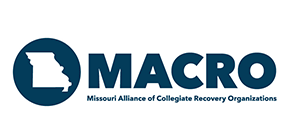 |
MACRO, the Missouri Alliance of Collegiate Recovery Organizations, is a statewide initiative to support addiction recovery efforts on college campuses. With support from the Missouri Department of Mental Health, MACRO provides resources, networking opportunities, and financial support for schools as they start and grow their own recovery support services. Click here to learn more about MACRO! |
Research
Relevant Research Articles
- College Drinking Fact Sheet. National Institute on Alcohol Abuse and Alcoholism
- Harmful Interactions – Mixing Alcohol with Medicines. National Institute on Alcohol Abuse and Alcoholism.
- National Institute on Alcohol Abuse and Alcoholism - Research
- How to Reduce High-Risk College Drinking: Use Proven Strategies, Fill Research Gaps.
- White & Hingson. (2014). The Burden of Alcohol Use. Alcohol Research and Current Reviews. 35(2): 201–218.
- Scott-Sheldon, L. A. J., Carey, K. B., Elliott, J. C., Garey, L., & Carey, M. P. (2014). Efficacy of alcohol interventions for first-year college students: A meta-analytic review of randomized controlled trials. Journal of Consulting and Clinical Psychology, 82(2), 177-188.
- Witkiewitz, K., Desai, S. A., Bowen, S., Leigh, B. C., Kirouac, M., & Larimer, M. E. (2014). Development and evaluation of a mobile intervention for heavy drinking and smoking among college students. Psychology of Addictive Behaviors, 28(3), 639-650.
- Hoffman, E.W., Pinkleton, B.E., Weintraub Austin, E. & Reyes-Velazquez, W. (2014). Exploring College Students’ Use of General and Alcohol-Related Social Media and Their Associations With Alcohol-Related Behaviors
- Pearson, M.R. (2013). Use of alcohol protective behavioral strategies among college students: A critical review
